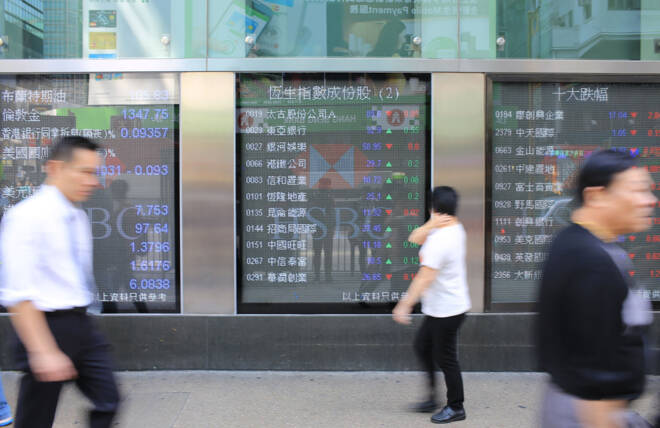Advertisement
Advertisement
Hang Seng Index: Gains Despite China Slowdown, Nikkei Steady on Inflation Data
By:
Key Points:
- Hang Seng gains 0.26% as China’s Q3 GDP slows to 4.6%, but upbeat September data lifts investor sentiment.
- Nikkei 225 rises 0.35% on softening inflation; USD/JPY supports gains as Japan’s inflation eases to 2.5%.
- ASX 200 falls 0.84% amid declining mining stocks, as China demand concerns impact BHP and Rio Tinto shares.
US Markets Mixed After Robust US Economic Data
On Thursday, October 17, US Equity Markets had a mixed session. The Dow and the Nasdaq Composite Index saw gains of 0.37% and 0.04%, respectively, while the S&P 500 slipped by 0.02%.
Travelers Companies Inc. (TRV) surged by 9% on better-than-expected earnings, contributing to the Dow’s gains. AI stocks remained the driving force behind the Nasdaq, with Arm Holdings (ARM) and NVIDIA Corp. (NVDA) seeing gains of 1.38% and 0.89%, respectively.
After hours, Netflix Inc. (NFLX) rallied 5.03% on beating Q3 earnings estimates.
US Retail Sales and Labor Market Data Impact Fed Rate Path
US retail sales increased by 0.4% in September after rising by 0.1% in August. Upward trends in retail sales could fuel demand-driven inflation, possibly delaying a December rate cut until Q1 2025.
Additionally, initial jobless claims beat forecasts, falling from 260k (week ending October 5) to 241k (week ending October 12). Tighter labor market conditions could support wage growth and boost consumer spending.
The data influenced sentiment toward the Fed rate path. According to the CME FedWatch Tool, the probability of a 25-basis point November Fed rate cut eased from 93.7% (October 16) to 90.6% (October 17). Additionally, the chances of a 25-basis point Fed rate cut in December stood at 74.3%, down from 85.6%.
China Economic Indicators Influence Risk Sentiment
Upbeat US economic data and positive earnings set the tone for the Friday Asian session. However, economic data from China also required consideration. Notably, the Chinese economy expanded by 4.6% year-on-year in Q3, down from 4.7% in Q2.
Nevertheless, upbeat economic data for September and hopes of more fiscal stimulus measures limited the impact on the Asian markets.
Expert Views on China’s Economy and Stimulus Measures
AMP Head of Research and Chief Economist Shane Oliver commented on China’s data, stating,
“China Q3 GDP slowed to 4.6%yoy. Mthly data for IP & retail sales were a bit > exp but still soft & looks like normal volatility with trend growth in IP, retail & investment remaining down (chart). Unemployment fell to 5.1% but also range bound. Too early for stimulus to impact.”
Hang Seng Index and Mainland China Equities Have a Mixed Morning
Turning to the Asian equity markets, the Hang Seng Index gained 0.26% in the Friday morning session. However, the economic data from China pulled the Index back from earlier highs.
Tech stocks had a mixed morning, with the Hang Seng Tech Index advancing by just 0.22%. Notable tech stock movers included Alibaba (9988) and Baidu (9888), which declined by 2.03% and 0.22%, respectively.
The Hang Seng Mainland Properties Index also saw modest gains, advancing by 0.45% despite a marked fall in house prices on the Mainland. China’s House Price Index fell 5.7% year-on-year in September after declining by 5.3% in August.
Mainland China’s equity markets struggled, with the CSI 300 and Shanghai Composite declining by 0.34% and 0.25%, respectively.
Nikkei Steadies as Inflation Softens
On Friday, the Nikkei Index gained 0.35% in the morning session. A stronger USD/JPY pair contributed to the Nikkei’s gains, with softer-than-expected inflation numbers from Japan driving demand for Nikkei Index-listed stocks. Japan’s annual inflation rate eased from 3.0% in August to 2.5% in September, possibly reducing bets on a Q4 2024 BoJ rate cut.
However, tech stocks capped the Nikkei’s gains, with Tokyo Electron (8035) and Softbank Group Corp. (9984) falling by 0.70% and 0.97%, respectively.
ASX 200 Slides on Labor Market Data
On Friday, the ASX 200 Index slid by 0.84% amidst shifting sentiment toward the timing of RBA and Fed rate cuts. A tighter Aussie labor market could signal increased household spending, which may fuel demand-driven inflation.
Concerns about demand from China impacted mining stocks. Mining giants BHP Group Ltd (BHP) and Rio Tinto Ltd. (RIO) slid by 1.77% and 0.89%, respectively, as iron ore spot tumbled by 5.03% on Thursday.
The prospects of a less dovish Fed rate path also affected banking stocks. National Australia Bank (NAB) and ANZ (ANZ) saw declines of 0.23% and 0.61%, respectively. Higher 10-year US Treasury yields eased demand for high-yielding Aussie banking stocks.
Looking Ahead
Investors should remain alert, with China and central bank commentary needing consideration. USD/JPY trends will continue to direct the Nikkei Index, while the US futures may affect broader market sentiment.
About the Author
Bob Masonauthor
With over 28 years of experience in the financial industry, Bob has worked with various global rating agencies and multinational banks. Currently he is covering currencies, commodities, alternative asset classes and global equities, focusing mostly on European and Asian markets.
Did you find this article useful?
Latest news and analysis
Advertisement
